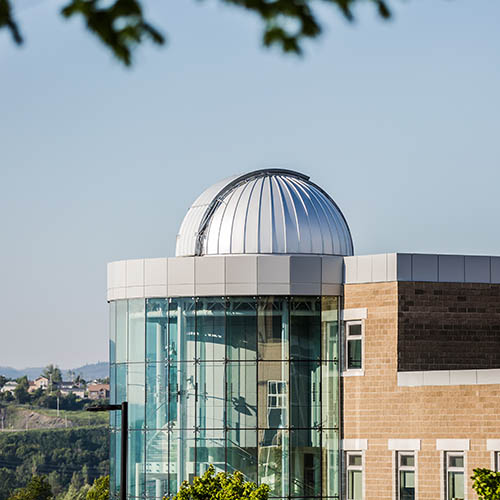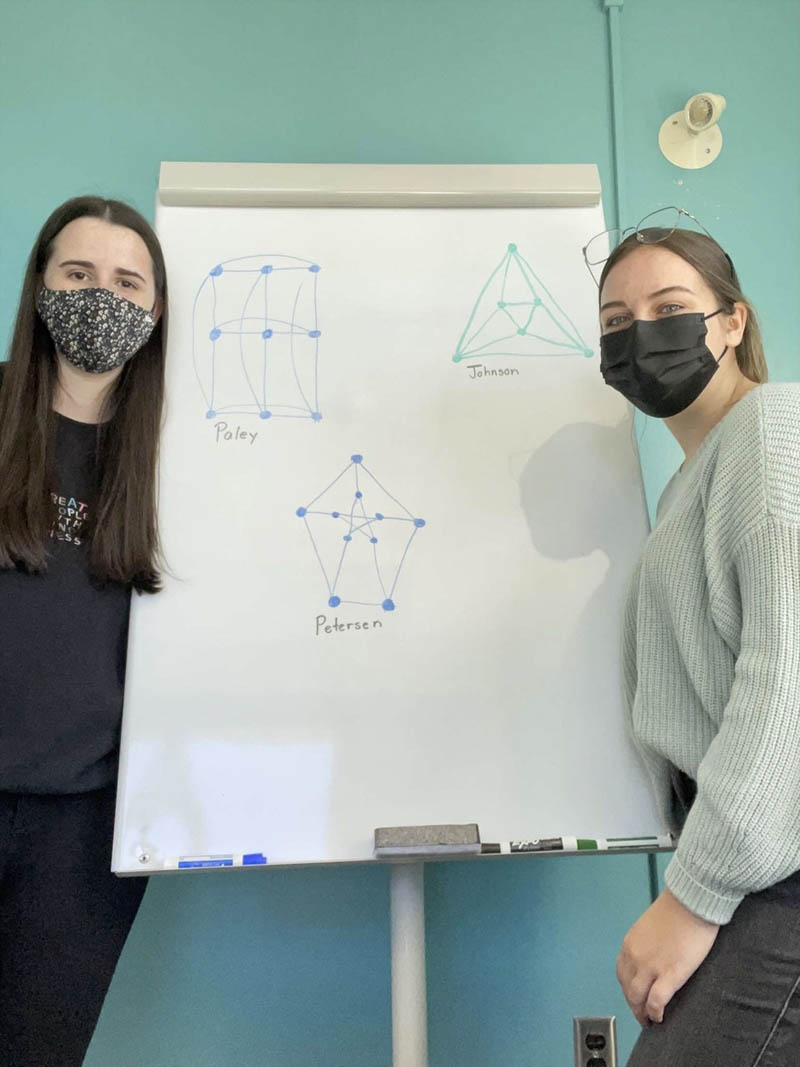Research Report: 2021
▼ Choose a report:

Powered by Research & Graduate Studies

Powered by Arts and Social Science

Powered by Fine Arts

Powered by Science and the Environment


From left, Alaina Pardy and Abigail Rowsell
Grenfell Campus was successful in landing eight Undergraduate Student Research Awards (USRAs) for the summer of 2021.
USRAs, awarded by the Natural Sciences and Engineering Research Council of Canada (NSERC), are meant to nurture students' interests and fully develop their potential for research careers in the natural sciences and engineering. They are also meant to encourage students to undertake graduate studies in these fields.
Dr. Robert Bailey, a math professor in Grenfell's School of Science and the Environment, was able to hire three students funded by USRAs. Alaina Pardy and Abigail Rowsell, two of the three, collaborated on "distance-regular graphs that arose from primitive groups." Outlines of all eight research projects are referenced below.
"NSERC USRA grants provide a unique opportunity to work directly with a professor on their research," said Ms. Pardy. "It helps expose you to topics that may not be covered in your normal classes and therefore it broadens your knowledge on your area of study. Through this, it's helpful in deciding which areas of your field you're most interested in. It also gives you research experience, which is beneficial if you go on to do a master's or PhD. Not only does it expose you to conducting research, which is typically a big part of completing these higher degrees, it can also be a good thing to put on applications to these programs as you're demonstrating that you have research experience."
Ms. Rowsell said the USRA gave her a new appreciation of her program, a B.Sc. in computational mathematics.
"The Computational Math degree at Grenfell includes courses from many fields of math; however, researching deeper into a particular field is not often an opportunity that a three-month semester course provides," she said. "This opportunity allowed me to experience and learn new concepts that I may not have had a chance to do in a classroom. Working one-on-one with an experienced supervisor also provided the chance to understand new and efficient ways at looking at math problems. This is knowledge I will certainly take with me as I continue my studies. I also had little to no understanding of what work math professors completed at Grenfell, but the NSERC USRA allowed me to experience it first-hand. I now can appreciate the work that mathematicians have done and continue to do and the effort it requires to advance the field further."
Both Ms. Pardy and Ms. Rowsell recommended that science students pursue these experiences.
Ms. Pardy noted, "these research opportunities give students the chance to better understand their field of study and it prepares them for research projects they may complete in their undergraduate degree or while completing their master's or PhD. It exposes students to ideas and topics they may not cover in a normal course and in turn allows them to study topics they are particularly interested in more thoroughly."
To learn more about NSERC's USRA program, click here.
1. Dr. Robert Bailey - Alaina Pardy
Cataloguing highly symmetric distance-regular graphs
Graph theory is the mathematical study of pairwise connections between objects (referred to as "vertices"), which could represent computers in a network, cities connected by direct flights, or atoms in an organic molecule, to give just a few examples. Group theory, a major branch of abstract algebra, is the mathematical study of the concept of symmetry, where "group actions" describe the symmetries of an object. Algebraic graph theory is often concerned with graphs with a high degree of symmetry or regularity, and exists in the overlap of these two disciplines. Distance-regular graphs are an important area of study in this field. The website www.distanceregular.org, maintained by Dr. Robert Bailey at Grenfell Campus, provides a growing database of distance-regular graphs in formats suitable for computations. A previous USRA project involved a computer analysis of distance-regular graphs arising from group actions, where the group is "primitive": loosely, this means that the symmetries cannot be broken down into separate components. That project was able to completely classify such graphs in many instances, where the graph had up to 4000 vertices; many of these graphs were already present in the database, but a significant number were not, particularly in the case of larger graphs. The purpose of this project is to expand the database to include all the graphs obtained in the previous classification, as well as to identify (and fill) other gaps in this collection.
2. Robert Bailey - Abigail Rowsell
Distance-regular graphs of prime-power order
Graph theory is the mathematical study of pairwise connections between objects (referred to as "vertices"), which could represent computers in a network, cities connected by direct flights, or atoms in an organic molecule, to give just a few examples. Group theory, a major branch of abstract algebra, is the mathematical study of the concept of symmetry, where "group actions" describe the symmetries of an object. Algebraic graph theory is often concerned with graphs with a high degree of symmetry or regularity, and exists in the overlap of these two disciplines. Distance-regular graphs are an important area of study in this field. A previous USRA project involved a computer analysis of distance-regular graphs arising from group actions, where the group is "primitive": loosely, this means that the symmetries cannot be broken down into separate components. That project was able to completely classify such graphs in many instances, where the graph had up to 4000 vertices; however, in the case where the size of the graph is a power of a prime number, further analysis is still needed. The purpose of this latest project is to investigate this situation in more detail. The website www.distanceregular.org, maintained by Dr. Robert Bailey at Grenfell Campus, provides a growing database of distance-regular graphs in formats suitable for computations; one outcome of this project will be to expand the database, as well as forming the basis of a peer-reviewed publication.
Using the GAP computer algebra system, the student will perform a systematic analysis of the GAP libraries of permutation groups, identifying examples of graphs with each group action, and then isolating the distinct examples. A related USRA project involves further development of the www.distanceregular.org database: there is significant potential for the two USRA students to collaborate on the two projects.
3. Robert Bailey - Aaron Dwyer
Combinatorial designs on square arrays
Combinatorial design theory is a branch of discrete mathematics concerned with arranging collections of objects in highly structured ways. The easiest example is a Latin square: this is a square array with n rows and n columns, where each cell is filled with a number chosen from 1,...,n in such a way that no symbol is ever repeated in any row or any column. (For example, the solution to a Sudoku puzzle is a 9x9 Latin square.) This subject has its origins in the design of statistical experiments (which is how the term "design" arose) for applications in field trials, yet also has connections with areas of pure mathematics such as geometry and algebra, and more modern applications to the accurate transmission and storage of data. Many combinatorial designs can be viewed as arrangements of objects on a square array (such as a Latin square); however, in more complex situations (where each entry of the array contains multiple symbols rather than just one) there are many unsolved questions. In a 2016 paper, Abel et al. considered "generalized Howell designs" (GHDs), where each entry of an array may contain a set of three symbols, in such a way that every symbol appears in each row and each column, but no two symbols every appear together more than once; this means that some cells may be left blank. The work of Abel et al. focused on situations where the number of blank cells was relatively small, but this leads to many pairings of symbols never appearing in the array. At the opposite end of the spectrum, most (or all) pairs will be used, but there will be a relatively large number of blank cells. This USRA project will be devoted to this latter situation.
4. Svetlana Barkanova - Johnathan Barrett
Virtual reality simulators in subatomic physics training and outreach
Immersive virtual reality is a promising educational technology with many learning benefits, and we already have experience with using our two VR sets for astronomy outreach. However, we do not yet have suitable programming for training and outreach in particle and nuclear physics. Building on the second-year subatomic physics course he completed and feedback from his fellow students, the local schools and the Qalipu First Nation community, Jonathan will assist with assessment of learning domains and tasks, and help to investigate options for learning assessment, collaboration, and data collection. We'll also look for the existing VR programs we could adopt as well designing our own such as simulations of particle collisions and nuclear processes such as fission and fusion.
5. Erin Fraser - William Rauch-Davis
Review of the use of intrinsic markers to study bat migration
My research group, including me, two M.Sc. students, and William, will be researching and writing a review paper in response to an invitation for a submission to a special issue of the open access journal, Animals. The title of the special issue is "Bat Biology in Relation to Wind Energy Development". We will review the use of different types of intrinsic biomarkers for researching bat migration and plan to submit the paper for peer review by August 2021. Most bat mortality around wind energy facilities occurs during the fall migratory season and the editors of the special issue have agreed that a review of techniques for researching bat migratory pathways is a timely and valuable addition to the issue. This project is directly contributes to my NSERC Discovery Grant funded research program. The review will include summaries of the use of analyses of light isotopes, radiogenic isotopes and trace metals for conducting origin assignment on migratory bats. For methods that have infrequently been used on bats, we will summarize their use on other taxa and highlight research opportunities for studying bat migration. We will further discuss the types of animal tissues that may be used for these analyses, as well as the considerations required when selecting a tissue type for analysis. Finally, we will include a section synthesizing the necessary research steps required to use any of the summarized techniques for bat origin analysis.
6. Lakshman Galagedara - Cole Tallack
Soil moisture variability estimated using near-surface geophysical methods under different soil management
With the continuously increasing demand for food together with climate change impacts, efficient agricultural management has become a necessity today than ever before. Precision agriculture has been identified as a key strategy for increasing agricultural productivity with minimum input and environmental damages. In order to facilitate the sustainable management of soil and water resources, knowledge of spatiotemporal variability of soil water and other relevant soil properties is needed. Traditional methods for measuring soil moisture within agricultural landscapes provide point scale information and they are tedious, time-consuming, and destructive. To address this issue, near-surface geophysical methods such as ground penetrating radar (GPR) and electromagnetic induction (EMI) have been tested as potential techniques to obtain spatiotemporal variability of soil moisture and other relevant soil properties. Under the different agronomic practices such as tillage or application of irrigation water, soil moisture, and other physical properties such as bulk density, porosity, etc., can be varied with the field. This project aims to estimate the spatio-temporal variability of soil moisture under different agronomic management using GPR and EMI methods as non-destructive and rapid methods. In achieving this goal, a manipulative experiment will be conducted under different agronomic management conditions with at least two different soil types.
7. Robert Scott - Chelsea Trask
Geographic variation in stickleback anti-predator armor
Variation among populations of a species (geographic variation) has been recognized for centuries, but only recently have scientists begun to appreciate that interpopulation variation may be a nearly universal phenomenon in both plants and animals. Mayr and others envisioned variation of this nature as the starting point for speciation1-3. Geographic variation is a phenomenon that can inform us about evolutionary patterns and processes, especially with regard to how new species are formed. The threespine stickleback fish (Gasterosteus aculeatus) is a model organism in the examination of evolutionary patterns and processes. Populations of this species are found in coastal marine and freshwater systems in the northern portion of the Holarctic biogeographical realm. Though marine populations are relatively uniform in a variety of behavioural, physiological and morphological traits across the entire range of the species, freshwater populations, which arose through colonization by marine forms of the new lakes and rivers that formed following the retreat of the Wisconsin ice sheets, are remarkably variable4. However, despite the wide array of regional studies of stickleback variation, some regions are still very poorly studied (eg. Russia, NE North America). Newfoundland and Labrador are in particular are very poorly studied. In the proposed research, I plan to explore morphological variation among populations of threespine stickleback from western Newfoundland and southern Labrador, focusing on anti-predator features body shape and assess variability in vertebral column morphology.
8. Olga Vasilyeva - Michael Willette
Reaction-diffusion-advection competition models in river networks
Ecologists offer a number of mechanisms that lead to coexistence between species. One of them is a trade-off between flow speed in an aquatic habitat and growth rate, as was first observed in [F. Lutscher, E. McCauley, M.A. Lewis, Spatial patterns and coexistence mechanisms in rivers, Theor. Pop. Biol. 58(2000), 211-237] using a spatial reaction-diffusion-advection (RDA) version of the Lotka-Volterra model. Namely, at low flow speeds, the competition outcome is determined by the relative strength of the competitors, while at higher flow speeds, the growth rate plays the decisive role in the competition. All these results were obtained in the setting of a single river segment represented by an interval of real line. An important role in further analysis of this model carried out in [O. Vasilyeva, F. Lutscher, How flow speed alters competitive outcome in advective environments, Bull. Math. Biol., 74(12)(2012), 2935-2958] was played by the spatial profile of a single species steady state of a logistic RDA model. Lately, the study of RDA models had been expanded to habitats such as river networks that can be described by an RDA model on a metric graph. In this project, we will focus on the simple Y-shaped river network and explore both the logistic RDA model of a single species, as presented in [O. Vasilyeva, Population Dynamics in River Networks: Analysis of Steady States, J. Math. Biol., Vol. 79 (1) (2019), 63-100], and its possible generalizations to the case of two competing species. As in the single river segment setting, the first step will be to explore the profile of a single species steady state in such a network, focusing on its dependence on advection speed. Numerical simulations will be used to study possible competition outcomes in the new setting.